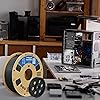









Ready to go? Add this product to your cart and select a plan during checkout. Payment plans are offered through our trusted finance partners Klarna, PayTomorrow, Affirm, Afterpay, Apple Pay, and PayPal. No-credit-needed leasing options through Acima may also be available at checkout.
Learn more about financing & leasing here.
Returnable until Jan 31, 2025
To qualify for a full refund, items must be returned in their original, unused condition. If an item is returned in a used, damaged, or materially different state, you may be granted a partial refund.
To initiate a return, please visit our Returns Center.
View our full returns policy here.
Color: Gray
Features
Brand: OVERTURE
Material: Nylon
Color: Gray
Item Weight: 1 Kilograms
Item Diameter: 1.75 Millimeters
Package Dimensions : 8.82 x 8.15 x 2.91 inches; 2.2 Pounds
Date First Available : April 27, 2020
Manufacturer : OVERTURE
Country of Origin : China
Best Sellers Rank: #8,755 in Industrial & Scientific (See Top 100 in Industrial & Scientific) #346 in 3D Printing Filament
#346 in 3D Printing Filament:
Customer Reviews: 4.4 4.4 out of 5 stars 637 ratings














